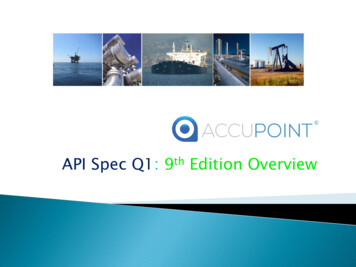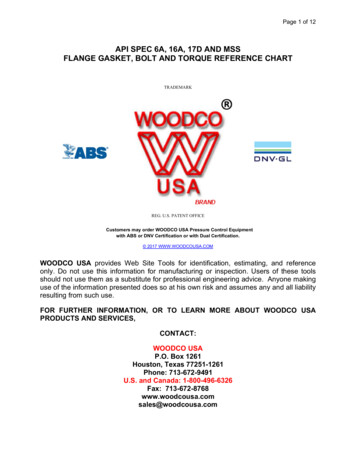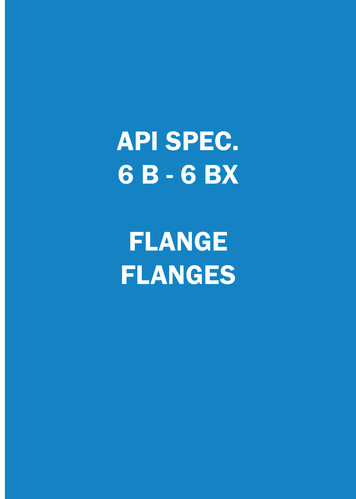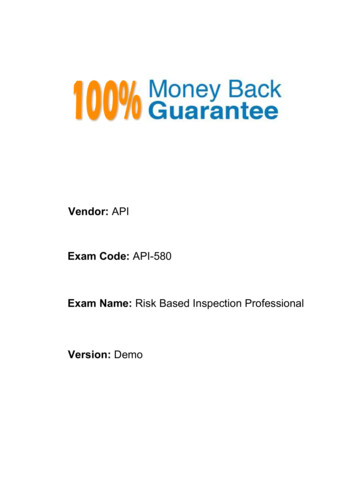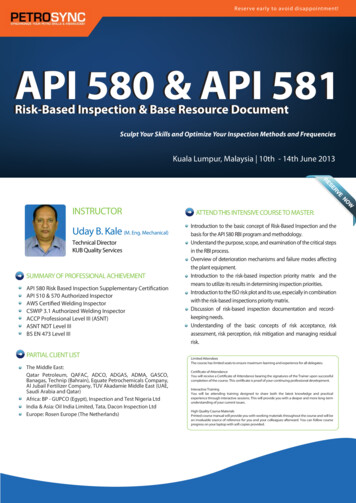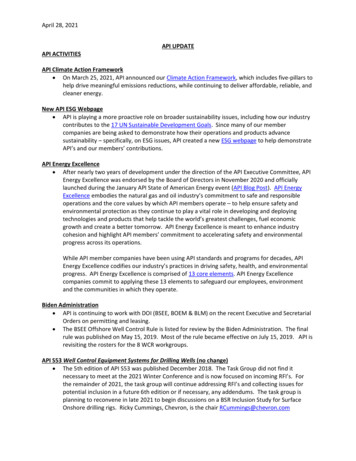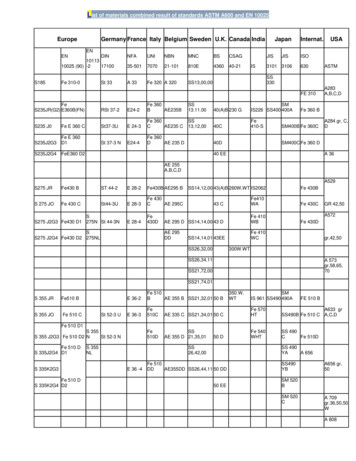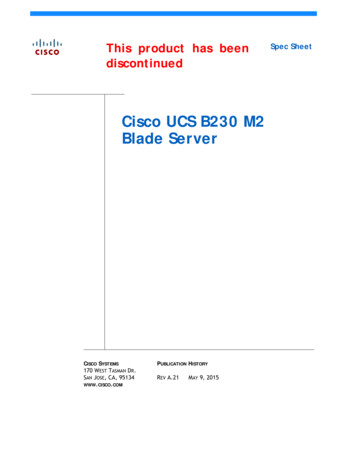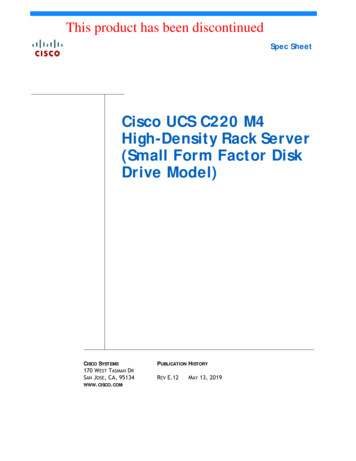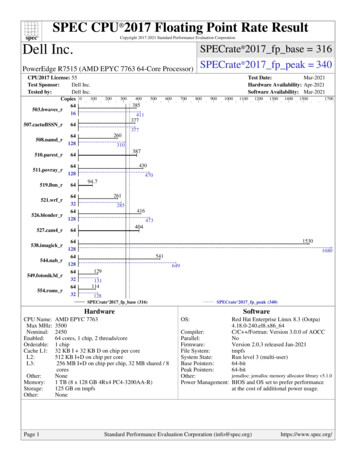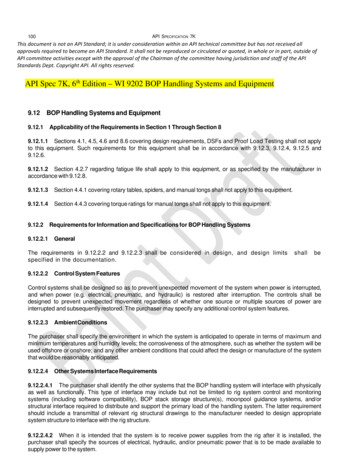
Transcription
API SPECIFICATION 7K100This document is not an API Standard; it is under consideration within an API technical committee but has not received allapprovals required to become an API Standard. It shall not be reproduced or circulated or quoted, in whole or in part, outside ofAPI committee activities except with the approval of the Chairman of the committee having jurisdiction and staff of the APIStandards Dept. Copyright API. All rights reserved.API Spec 7K, 6th Edition – WI 9202 BOP Handling Systems and Equipment9.12BOP Handling Systems and Equipment9.12.1Applicability of the Requirements in Section 1 Through Section 89.12.1.1 Sections 4.1, 4.5, 4.6 and 8.6 covering design requirements, DSFs and Proof Load Testing shall not applyto this equipment. Such requirements for this equipment shall be in accordance with 9.12.3, 9.12.4, 9.12.5 and9.12.6.9.12.1.2 Section 4.2.7 regarding fatigue life shall apply to this equipment, or as specified by the manufacturer inaccordance with 9.12.8.9.12.1.3Section 4.4.1 covering rotary tables, spiders, and manual tongs shall not apply to this equipment.9.12.1.4Section 4.4.3 covering torque ratings for manual tongs shall not apply to this equipment.9.12.29.12.2.1Requirements for Information and Specifications for BOP Handling SystemsGeneralThe requirements in 9.12.2.2 and 9.12.2.3 shall be considered in design, and design limitsspecified in the documentation.9.12.2.2shallbeControl System FeaturesControl systems shall be designed so as to prevent unexpected movement of the system when power is interrupted,and when power (e.g. electrical, pneumatic, and hydraulic) is restored after interruption. The controls shall bedesigned to prevent unexpected movement regardless of whether one source or multiple sources of power areinterrupted and subsequently restored. The purchaser may specify any additional control system features.9.12.2.3Ambient ConditionsThe purchaser shall specify the environment in which the system is anticipated to operate in terms of maximum andminimum temperatures and humidity levels; the corrosiveness of the atmosphere, such as whether the system will beused offshore or onshore; and any other ambient conditions that could affect the design or manufacture of the systemthat would be reasonably anticipated.9.12.2.4Other Systems Interface Requirements9.12.2.4.1 The purchaser shall identify the other systems that the BOP handling system will interface with physicallyas well as functionally. This type of interface may include but not be limited to rig system control and monitoringsystems (including software compatibility), BOP stack storage structure(s), moonpool guidance systems, and/orstructural interface required to distribute and support the primary load of the handling system. The latter requirementshould include a transmittal of relevant rig structural drawings to the manufacturer needed to design appropriatesystem structure to interface with the rig structure.9.12.2.4.2 When it is intended that the system is to receive power supplies from the rig after it is installed, thepurchaser shall specify the sources of electrical, hydraulic, and/or pneumatic power that is to be made available tosupply power to the system.
This document is not an API Standard; it is under consideration within an API technical committee but has not received allapprovals required to become an API Standard. It shall not be reproduced or circulated or quoted, in whole or in part, outside ofAPI committee activities except with the approval of the Chairman of the committee having jurisdiction and staff of the APIStandards Dept. Copyright API. All rights reserved.9.12.2.4.3 The purchaser shall specify the applicable codes, standards, and regulatory requirements that shallapply to electrical equipment, components, fittings, cabling, and their installation, including applicable requirementsfor hazardous area or zone classifications in which the BOP handling system is to be installed.9.12.2.4.4 The purchaser, at his/her option, shall specify the type of third-party certification required for the system.9.12.2.5 Loading Conditions
This document is not an API Standard; it is under consideration within an API technical committee but has not received allapprovals required to become an API Standard. It shall not be reproduced or circulated or quoted, in whole or in part, outside ofAPI committee activities except with the approval of the Chairman of the committee having jurisdiction and staff of the APIStandards Dept. Copyright API. All rights reserved.9.12.2.5.1 The maximum static load that will be handled by the system shall be specified. This shall include theentire BOP stack and all its attachments.9.12.2.5.2 The dynamic loads that the system will be exposed to shall be specified, including, but not limited to,maximum wind velocity, accelerations caused during transportation if the system is portable, accelerations caused byoffshore vessel motion criteria, side loading and/or operation requirements at angles misaligned with the normalload path, and/or other dynamic forces that would be anticipated during system operation.9.12.2.5.3designer.The purchaser shall specify wave slamming loads if this needs to be considered by the equipment9.12.2.5.4 The purchaser shall specify load response from riser hang-off if this needs to be considered by theequipment designer.9.12.39.12.3.1Subsystem Design RequirementsGeneralDesign requirements and specifications of subsystems and/or system components are specified as follows.9.12.3.2Piping SystemsValve DSFs shall meet or exceed those required by ASME B16.34 and NFPA T2.12.10 R1 or other recognizedinternational standard for this type of application. For piping systems, safety factors shall meet or exceed therequirements specified in ASME B31.3, hydraulic circuit design shall incorporate features that will allow isolationof components such as pressure relief, pressure regulating, and counter-balance valves for replacement andmaintenance without having to drain the system of hydraulic fluid. Functional redundancy and bypass circuits shallalso be employed to increase reliability. Hydraulic hoses shall only be utilized where there is a requirement toaddress misalignment, relative movement between components, thermal expansion and contraction, and vibration.Otherwise, rigid piping/tubing shall be utilized.9.12.3.3Wire RopeSteel wire rope design factor for running applications shall not be less than 3.Steel wire rope forming part of sling and for mast stays, pendants and similar standing applications shall have adesign factor not less than 5.Reeving efficiency, end termination efficiency and D/d-ratio (Wire sheave / Rope) shall be considered duringselection of wire rope.9.12.3.4SlingsSlings made from wire rope, chain, or synthetic materials shall be fabricated and certified per ASME B30.9 orequivalent. Wire rope slings shall incorporate the end termination efficiency and a wire rope design factor of 5 intheir rated capacity. The rated capacity of each sling shall be shown on a tag attached to the sling.9.12.3.5Off-the-shelf Loose GearOff-the-shelf loose gear selected for use in BOP handling systems, such as shackles, hooks, chain, binders, swivels,turnbuckles, sheave blocks, and connecting links, shall have a working load limit published by the manufacturer thatequals or exceeds the design load of the load path they are used in.
This document is not an API Standard; it is under consideration within an API technical committee but has not received all approvalsrequired to become an API Standard. It shall not be reproduced or circulated or quoted, in whole or in part, outside of APIcommittee activities except with the approval of the Chairman of the committee having jurisdiction and staff of the API StandardsDept. Copyright API. All rights reserved.9.12.3.6Hydraulic Hoses9.12.3.6.1The use of hydraulic hoses shall be kept to an absolute minimum required to compensate for vibration,thermal expansion and contraction, misalignment, or relative movement required between the hydraulic hose endterminations.9.12.3.6.2Hydraulic hoses shall meet the requirements of SAE J 517 and shall have a working pressure equal to orexceeding the piping system into which they are installed. The minimum burst pressure of hydraulic hoses shall be aminimum of four times the working pressure of the hose, as specified by the hydraulic hose manufacturer.9.12.3.6.3Only hydraulically crimped type hydraulic hose end fittings shall be used. Swivel-type end fittings that arewidely available are recommended to be installed at each end of the hydraulic hose to prevent hose twisting duringinstallation and removal. No hot-dip galvanized end fittings shall be used and no PTFE tape shall be applied to anypressure sealing threaded connections, such as national pipe thread (NPT) threads.9.12.3.6.4Raw hose body material used to fabricate hydraulic hose assemblies shall not be older than five yearsfrom the date of manufacture and shall be suitable and compatible with the media being conveyed.9.12.3.6.5The outer cover of the hydraulic hose body of all hydraulic hose assemblies shall not be painted.9.12.3.6.6All hydraulic h o s e s a n d hose assemblies (i.e. those located on a machine and/or dragchain andjumper/hook-up) shall be internally cleaned after pressure testing to ensure that any contamination inside thehydraulic hose assembly will not adversely affect system operation. Hydraulic hose assemblies shall be cappedand sealed after pressure testing and cleaning.9.12.3.6.7When installing hydraulic hose assemblies, they shall be routed and secured in such a manner that willavoid kinking or bends in the hydraulic hose body that are less than the published minimum bending radius.Additional protection shall be provided to the outer cover of the hydraulic hose in way of contact with surfaces subjectto vibration.9.12.3.6.8Each hydraulic hose assembly shall be pressure tested to a minimum of 1.5 times the working pressureof the hydraulic hose body prior to cleaning. Fluid should be used as the pressure testing media.9.12.3.6.9A list of all hydraulic hose assemblies utilized in the system shall be provided in an attachment to thesystem parts manual, which shall specify as a minimum, the equipment manufacturer part number.9.12.3.7Mechanical ComponentsThe design of mechanical components including but not limited to shafting, clevis linkages, gears of all types,keyways, splines, etc. shall meet the requirements of 9.12.4 to determine the design load. A DSF shall then beapplied in accordance with 9.12.5.9.12.3.8Attachments to Rig StructureThe manufacturer shall provide r e a c t i o n l o a d s for each i n te r f a c e to the rig structure that isnecessary for the purchaser to be able to design supporting structure for mounting and/or founding the system onthe rig.9.12.3.9Electrical Power and Control System ComponentsThe specifications for electrical power and control system components such as AC or DC motors, variable frequencydrives, electrical enclosures, switches, relays, circuit breakers, and other components, as well as electrical cabling,etc., and the suitability of such components for installation in hazardous areas or zones shall meet the requirementsof all applicable requirements specified in the purchase agreement.
This document is not an API Standard; it is under consideration within an API technical committee but has not received all approvalsrequired to become an API Standard. It shall not be reproduced or circulated or quoted, in whole or in part, outside of APIcommittee activities except with the approval of the Chairman of the committee having jurisdiction and staff of the API StandardsDept. Copyright API. All rights reserved.9.12.3.10BOP Stack Storage StructuresThe design of BOP stack storage structures shall be based on the governing static and dynamic loads for storage ofthe BOP Stack.9.12.3.11BOP Stack Lifting Attachment PointsBOP attachment points for lifting BOPs and/or BOP stacks should be specified by the original equipmentmanufacturer including any limitations.9.12.3.12Control System FeaturesControls for raising, lowering, and transporting the load shall be designed such that they will return to neutral whenthe operator releases the control, which shall cause the brakes and/or load-holding device to be set automatically.Controls for the brakes and/or load-holding devices shall be designed such that they shall not disengage until theoperator of the system activates the function on which the brake and/or load-holding device is engaged. If the loadholding device is activated as a result of a power loss, the control system shall be designed to ensure that it shallremain engaged when power is restored.9.12.3.13Sheave/Winch Drum Diameter to Wire Rope Diameter RatiosThe ratio of wire rope sheave diameter to the wire rope diameter used with the sheave shall be a minimum of 18-to-1.The drum pitch diameter to the wire rope diameter wrapped on a drum that is part of a BOP handling system shall be aminimum of 18-to-1. Exception to these requirements may be taken when space constraints and othercircumstances dictate smaller ratios. In these cases, sheaves and/or drums should be provided that have the largestratio that can be installed, operated, and maintained in the space provided. For systems that are supplied withsheaves and/or drums having smaller ratios than 18-to-1, the manufacturer shall include a statement in the systemoperating and maintenance manual to the effect that the purchaser should be aware of the reduced fatigue life of thewire rope utilized with such sheaves and/or drums.The strength of a wire rope assembly shall be derated for end connection efficiencies and for D/d ratios less than18 in accordance with API RP 9B.9.12.3.14Wire Rope Hoist FeaturesWire rope hoists shall incorporate a brake and/or load holding device as described in 9.12.3.20. Level-wind devicesshall be considered when wire rope to drum fl
100 API SPECIFICATION 7K This document is not an API Standard; it is under consideration within an API technical committee but has not received all approvals required to become an API Standard. It shall not be reproduced or circulated or quoted, in whole or in part, outside of
![API Ballot: [Ballot ID] – API 510 & API 570, Deferrals, Rev05](/img/5/api510andapi570deferralsrev5.jpg)
